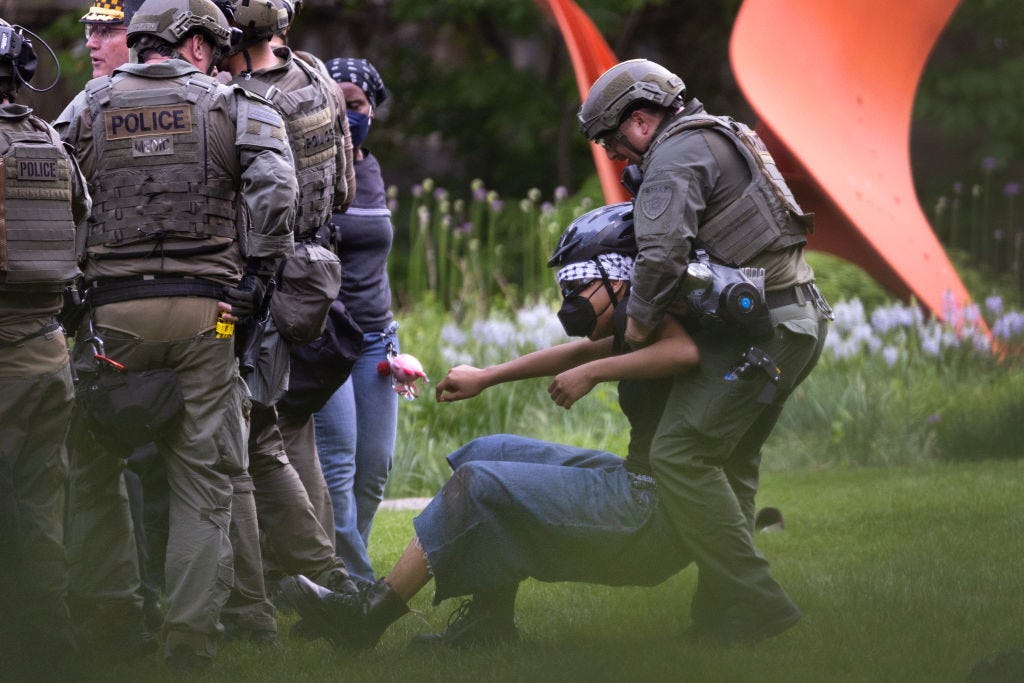The university president who doesn't fear his students, but won't pander to them
Wesleyan’s Michael Roth on the protests over Gaza, his logic in avoiding arrests, the real antisemitism issue he sees, and how the chaos could serve to elect Trump -- or be cleverly turned against him
In recent weeks, the wave of antiwar protest that began at Columbia University spread across the country, as did the backlash against it.
Many university leaders responded by shutting down student speakers, canceling commencement ceremonies, and ultimately calling in police to clear encampments and campus building occupations with mass arrests. Thousands of students, professors, and other protestors have been arrested nationwide; meanwhile, protests are ongoing, the House Committee on Education and the Workforce continues its fishing-expedition investigation of higher education, and the domestic battle over the campus protests continues to distract attention from the ongoing war in Gaza.
What is right here? Should universities crack down on students who disrupt campus life, even if their cause is just? Are there steps student groups could take to more clearly separate their movements from elements of antisemitism? Can the rest of society muster enough historical memory and thick enough skin to remember that students are often telling us something that we need to hear, even if we don’t want to?
One university leader has been grappling with these questions in an especially thoughtful way, in part because, in addition to running a university, he is a scholar of universities and of education. That grounding shows. Under Michael Roth, Wesleyan University has cut a different path from many campuses, by clearly and calmly reiterating students’ right to protest peacefully, as Roth did in this letter:
The students there know that they are in violation of university rules and seem willing to accept the consequences. The protest has been non-violent and has not disrupted normal campus operations. As long as it continues in this way, the University will not attempt to clear the encampment.
At the same time, Roth has been clear about the importance of keeping people’s focus on the underlying war, not elite campuses; on the very real problem of antisemitic elements in and around the protests; and about the need to sustain campuses as places where students and teachers and others expect a mix of safety and challenge.
We caught up with Roth the other day for a conversation you won’t want to miss if you’ve been following not only the war but the fight over the war and are craving, as we have been, more light and less heat.
A request for those who haven’t yet joined us: The interviews and essays hat we share here take research and editing and much more. We work hard, and we are eager to bring on more writers, more voices. But we need your help to keep this going. Join us today to support the kind of independent media you want to exist.
And today we’re offering new paying subscribers a special discount of 20 percent. You will lock in this lower price forever if you join us now!
Your statement of Wesleyan’s position on the continuing protests is notable for its simple recognition of the rights and responsibilities of all parties.
Can you talk about the decisions that went into your statement and why such statements have been so rare?
I am happy to talk about my statement, but I really want to emphasize that we need to turn more political energy toward demanding that the U.S. force a humanitarian ceasefire in Gaza, a return of the hostages, and, then, negotiations toward a sustainable peace.
As for protests at Wesleyan University: We could have immediately closed down the encampment because the protesters hadn’t gotten advance permission for tents, or because they were writing messages on the adjacent buildings in chalk. But in the context of national protest movements, it seemed wrong to me to use “time and place restrictions” other schools have cited as reasons for shutting down protests.
Over the last week, I’ve gotten many notes from alumni, parents, and strangers chastising me for not making the protesters “pay a price” for breaking the rules.
So why haven’t I made them feel those consequences? Cops don’t always give people tickets for going a few miles over the speed limit. Context matters, whatever Congresswoman Elise Stefanik says.
In this case, I knew the students were part of a broad protest movement, and protest movements often put a strain on an institution’s rules. They are meant to do that. The encampment was “non-violent and has not disrupted normal campus operations,” I wrote, and “as long as it continues in this way, the University will not attempt to clear the encampment.” I added that we would “not tolerate intimidation or harassment of students, staff, or faculty,” and that the protesters, as far as I could tell, were not moving in those directions. I want to emphasize that this can change and that if the protesters choose to more seriously disrupt our work as an educational institution, they will face much more significant repercussions.
Last Tuesday we saw two very different conclusions to major campus protests; at Columbia, the administration — claiming it had “no choice” — called in the NYPD, made multiple arrests and cleared the Hamilton Hall occupation and lawn encampment. (Yale, UCLA, and others did similarly.) Reportedly, Columbia has arranged for the NYPD to remain on campus through the conclusion of the term on May 17. On the other hand, student protestors at Brown finally reached an agreement with the Corporation of Brown University to dismantle their encampment in exchange for a vote on divestment from firms connected to the Israeli military campaign. Admittedly, I am asking you to speculate, but can you think through what the process behind these different decisions might have been?





